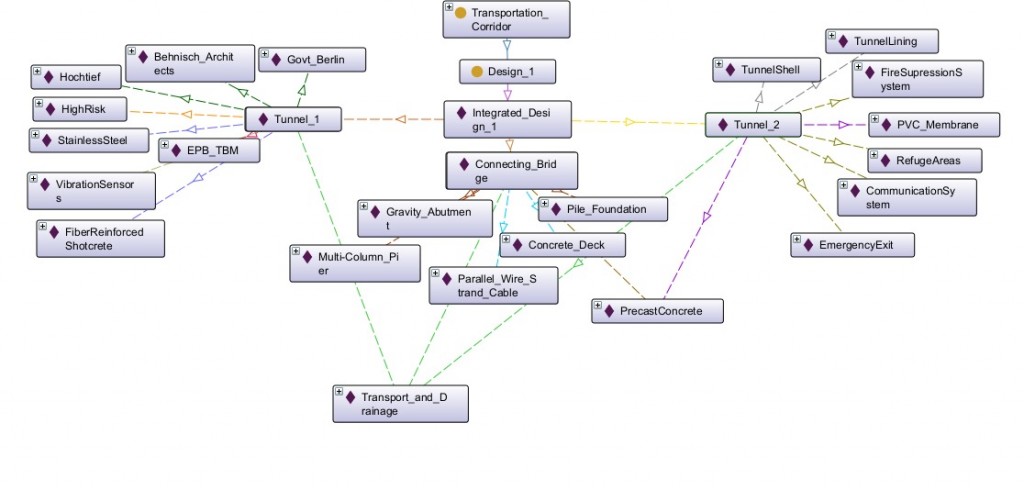Integrated Transportation Corridor ontology of Tunnel and Bridge Systems
1. Scope
This ontology integrates three civil infrastructure systems:
- Tunnel 1: Focuses on cost and stability optimization through material selection, construction methods, and stakeholder involvement.
- Connecting Bridge: Designed for structural stability over challenging terrains such as valleys or rivers.
- Tunnel 2: Emphasizes safety engineering, including evacuation plans, ventilation, and monitoring systems.
2. Purpose
The purpose of this ontology is to provide a structured knowledge model that enables engineers, planners, and researchers to analyze and optimize tunnel and bridge systems efficiently. It helps in decision-making for material selection, cost estimation, safety enhancement, and structural stability.
3. Process
- Defining the core entities and relationships of each system.
- Identifying overlaps and connections between tunnel and bridge models.
- Extending the ontology by incorporating missing links and shared attributes.
- Integrating functional, structural, and safety elements into a unified framework.
4. Methodology
- Ontology Development: Using Protégé, we structured the systems into interconnected classes, properties, and relationships.
- Knowledge Integration: Merged the distinct ontologies of tunnels and bridges by aligning concepts and adding interdependencies.
- Validation & Refinement: Ensured logical consistency and tested the model against real-world engineering scenarios.
5. Working
Engineers can query the ontology for insights on material selection, safety planning, or structural stability. The ontology allows for scenario-based evaluations, such as how different geological conditions impact tunnel stability or how a bridge’s design adapts to load variations. The model is extensible, meaning it can integrate additional systems like roads, railways, and smart monitoring tools in the future.
6. Key Features
- Multi-disciplinary integration: Combines cost analysis, structural engineering, and safety measures into one model.
- Data-driven decision making: Supports simulations and optimization studies.
- Scalability: Can be expanded with additional infrastructure elements.
7. Conclusion
This integrated ontology represents a step toward intelligent, automated civil infrastructure planning. By combining multiple perspectives—cost efficiency, structural integrity, and safety—it provides a holistic approach to modern transportation systems. The model is a valuable tool for researchers, engineers, and decision-makers in civil engineering.

Click Below to access the OWL file for this integrated Ontology:
Introduction|Individual Systems|Integrated Engineering Context|Integrated Ontology|Integrated Parametric Model|Group Members